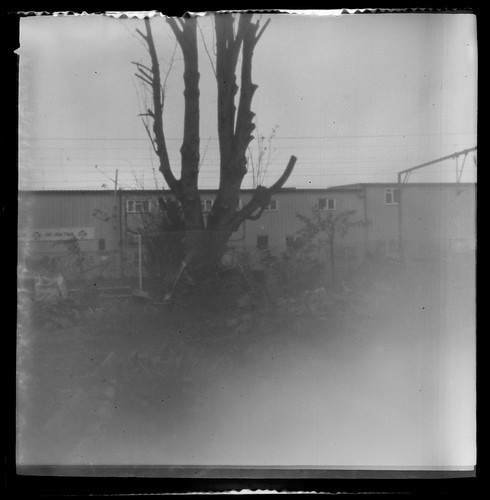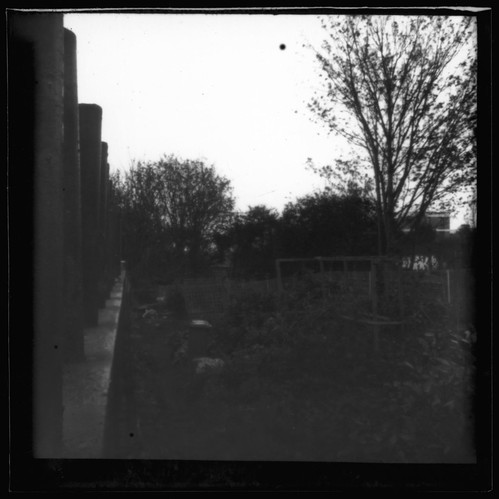I haven't been very active on Flickr recently for a number of reasons, but a couple of days ago while looking at my photostream, I noticed some tags to the images that I hadn't added. These tags are in white boxes, different from the grey boxes that the tags I had added to my photographs. At the top of the tags section, 'Beta' has been added, and a query box shows up the following message:
Tags are keywords that make photos easier to find in Flickr search. The ones you add will show up in dark gray. Flickr’s friendly robots will try to help out by adding some for you; these will appear with just a gray outline.
Looking through my photostream, many of the robot-generated tags appeared to be very generic: 'indoor' and 'outdoor' being among the most common, generic enough to be of little use when searching for something I would suspect. Some tags, however, were simply wrong. I have many photographs of old cameras, most of which have been tagged 'electronics'. This may be an understandable mis-indentification of any camera as being or using electronics. Some are more baffling: a
photograph of retouching inks labelled as 'food', 'beverage' and 'people';
riot police labelled as 'flower' and 'plant'; a
derelict garage as 'vehicle' and 'train'; a
building as 'vehicle' and 'bike'; there are many, many other examples of this misidentification.
On Flickr's help forum, an official thread begun on 7th May announces the changes:
Starting this morning, in addition to any tags that you add to your photos, you’ll notice that Flickr may also add tags to help make them more discoverable in search. This is thanks to Flickr’s image recognition technology, which recognizes patterns in photos. For instance, when our technology recognizes patterns commonly found in car photos, it will label the image “car” and when it finds patterns commonly found in cat photos, it will label the image “cat.”
You’ll notice that tags added by Flickr will appear in an outlined box to make them visually distinct from the ones you add (which appear in a gray box). As the photo’s owner, you can delete any tags you don’t want or tags that are inaccurate.
Inaccurate tags
While we are very proud of this advanced image recognition technology, we’re the first to admit there will be mistakes and we will constantly be working to improve the experience. Usually, you can tell why a mistake was made (sometimes a bike looks like a motorcycle), but occasionally, it may be baffling (no, your grandma doesn’t look like a cat!). But the good news is that if you delete an incorrect tag, our algorithm learns from that mistake and will perform better in the future.
As a Flickr user with over 2,600 photographs, this process is going to involve a good deal of
my time to improve
their automated processes; there are some accounts with tens of thousands of images. It is also hard to understand how the algorithm will improve if I delete technically accurate tags, like 'outdoor' that I do not want on my photographs. Over the past eight years as a member, I have considered the tags I've added to my photographs to be as much a part of the photographs' presentation as the titles and descriptions that I also add. The automated tags are an essential part of the new feature 'camera roll' in 'magic view' mode, where it is easy for the user to see wrongly tagged images. Flickr's auto-tagging had been an invisible component of its search function for some time, but now these tags are public; however, it may not be clear to the casual browser that the tags with the grey outline are not added by the photographer. One glaring problem with the automated process is that it does not cross reference with users' tags: the photograph of riot police is tagged, by me, 'Metropolitan Police', 'demo' and 'protest', so it would be unlikely to also be 'flower' and 'plant'.
The announcement of the official help forum post ends:
Here’s your chance to tell us about your experience: Please feel free to share your most impressive (yay!), most unexpected (boo!), or most hilarious (ha!) results in this thread. We look forward to hearing from you.
As a Flickr user who has stayed with the site through a number of changes that I've not appreciated, I am used to the infantile language; users have told Flickr about their experiences. At the time of writing there are over 2,000 responses on the thread, the vast overwhelming majority being negative, and the main complaint being that the automated tagging was not offered as an opt-in, nor is there any way to remove all automated tags as a batch. I can understand that for some users, automated tagging
may be a useful function, especially as Flickr wants "to make it the one place where you upload every photo and video you take, and then easily find, organize, edit, and share them". I am not one of these users - I probably post less than one in ten photographs I take, and as explained, I carefully tag
my photographs to describe the attributes
I want to draw attention to. One of the most "most unexpected (boo!), or most hilarious (ha!) results" of the automated tagging has been
photographs of Auschwitz labelled as 'sport'.




